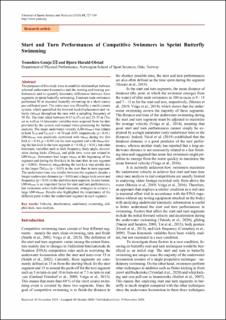| dc.contributor.author | Gonjo, Tomohiro | |
| dc.contributor.author | Olstad, Bjørn Harald | |
| dc.date.accessioned | 2021-03-04T14:01:00Z | |
| dc.date.available | 2021-03-04T14:01:00Z | |
| dc.date.created | 2020-12-25T02:21:47Z | |
| dc.date.issued | 2020 | |
| dc.identifier.citation | Journal of Sports Science and Medicine. 2020, 19(4), 727-734. | en_US |
| dc.identifier.issn | 1303-2968 | |
| dc.identifier.uri | https://hdl.handle.net/11250/2731691 | |
| dc.description | This work is licensed under a Creative Commons Attribution-NonCommercial-NoDerivatives 4.0 International License. | en_US |
| dc.description.abstract | The purposes of this study were to establish relationships between selected underwater kinematics and the starting and turning performances and to quantify kinematic differences between these segments in sprint butterfly swimming. Fourteen male swimmers performed 50 m maximal butterfly swimming in a short course pre-calibrated pool. The entire race was filmed by a multi-camera system, which quantified the forward head displacement and velocity (vxhead) throughout the race with a sampling frequency of 50 Hz. The time taken between 0-15 m (T0-15) and 25-35 m (T25-35) as well as 16 kinematic variables were acquired from the data provided by the system and manual video processing for further analysis. The mean underwater velocity (UW-vxmean) was related to both T0-15 and T25-35 (r = -0.70 and -0.95, respectively; p < 0.01). UW-vxmean was positively correlated with vxhead during the first kick (r = 0.84, p < 0.001) in the start segment and with vxhead during the last kick in the turn segment (r = 0.68, p < 0.01), but other kinematic variables such as kick frequency, body angle, deceleration during kicks (Deckick), and glide time were not related to UW-vxmean. Swimmers had larger vxhead at the beginning of the segment and during the first kick in the start than in turn segment (p < 0.001). However, vxhead during the last kick was similar due to the larger Deckick (p < 0.05) in the start than in turn segment. The underwater time was similar between the segments despite a longer underwater distance (p < 0.01) and a larger kick count and frequency (p < 0.01) in the start than turn segment. In conclusion, UW-vxmean is an important factor for start and turn performances, but swimmers select individual kinematic strategies to achieve a large UW-vxmean. Results also highlighted the importance of the different parts within the underwater segment in each segment. | en_US |
| dc.language.iso | eng | en_US |
| dc.subject | velocity | en_US |
| dc.subject | deceleration | en_US |
| dc.subject | undulatory swimming | en_US |
| dc.subject | dolphin kick | en_US |
| dc.subject | race analysis | en_US |
| dc.title | Start and turn performances of competitive swimmers in sprint butterfly swimming | en_US |
| dc.type | Peer reviewed | en_US |
| dc.type | Journal article | en_US |
| dc.description.version | publishedVersion | en_US |
| dc.rights.holder | © Journal of Sports Science and Medicine | en_US |
| dc.source.pagenumber | 727-734 | en_US |
| dc.source.volume | 19 | en_US |
| dc.source.journal | Journal of Sports Science and Medicine | en_US |
| dc.source.issue | 4 | en_US |
| dc.identifier.cristin | 1863200 | |
| dc.description.localcode | Institutt for fysisk prestasjonsevne / Department of Physical Performance | en_US |
| cristin.ispublished | true | |
| cristin.fulltext | original | |
| cristin.qualitycode | 1 | |
